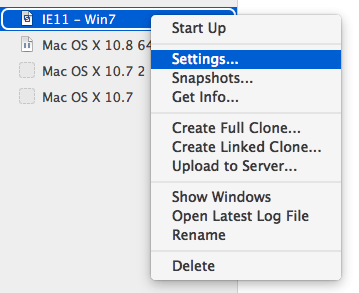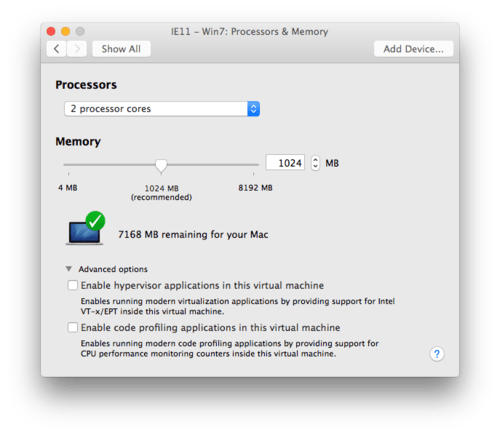Speed up Modern.ie virtual machines in VMware
If you haven’t been to Modern.ie and you’re a web developer, you really should. Microsoft provides free VMs (Virtual Machines) for pretty much every Internet Explorer configuration imaginable for every major VM platform: Parallels, VMware, VirtualBox etc.
Strangely the VMs come pre-configured with below the recommended settings for VMware. It only takes a minute or two reconfigure the virtual machines properly.
Step #1:
Shut down your virtual machine
Step #2:
Right click your VM and click settings

Step #3:
Under settings, click “Processor’s and Memory”. First you’ll want to give your VM access to at least 2 processor cores if you’re on an i5 or i7 or Core2Quad..

Secondly, you’ll want to allow the VMware machine access to at least the recommended amount of RAM. If you’re a a computer with an ample amount of RAM (16GB) you may want to give double the recommended amount of RAM for increased performance.
You may note the “Enable Hypervisor applications in this virtual machine” which may benefit speed for Windows XP, Windows Vista and Windows 7 configurations and Parallels recommends it for speed.
To quote StackOverflow poster David Pokluda
The main difference is that Hyper-V doesn’t run on top of the OS but instead along with the system it runs on top of a thin layer called hypervisor. Hypervisor is a computer hardware platform virtualization software that allows multiple operating systems to run on a host computer concurrently.
Sounds good right? However for Windows 8 it requires additional configuration and so does Windows 8.1. You’ll want to enable Hypervisor for Windows 8 if you intend to use Visual Studio or the Windows Phone SDK. Note: If you do not properly configure it will decrease performance for Windows 8 since Windows 8 has drivers for Intel Vt engine built in.
So should you or shouldn’t you use it? For Windows XP, Vista and 7, yes, otherwise for Windows 8, check the links above. If you have any doubts, you can safely skip enabling hypervisor as it only provides modest gains for VM performance when running one VM for browser testing.
Step #5
Boot your VM, VMware may ask you to upgrade, click yes. Once booted Windows will install new drivers and need to reboot. Reboot one last time, and enjoy.